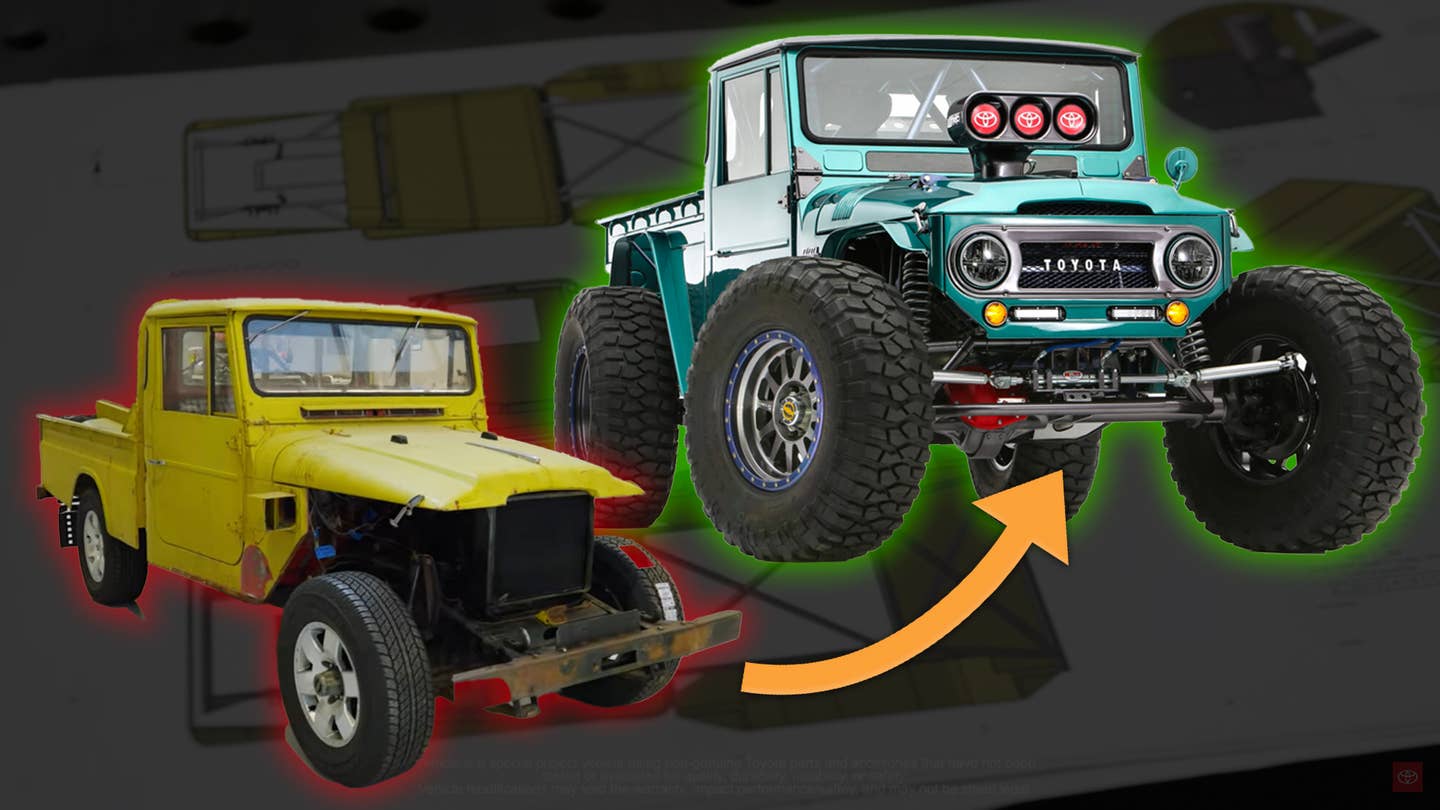This 1966 Toyota FJ45 doesn’t just look cool—it’s built to be functional and showcases some really neat off-road creativity with a tank track skid plate.

SEMA—the big aftermarket car parts showcase that takes over Las Vegas around every Halloween—has a reputation similar to the city itself. All style over substance; slapdash imitations of cool things running on high-viscosity snake oil. Now that I’ve seen SEMA for myself I’m pleased to report that the show is actually way cooler than I’d expected, and these videos documenting Toyota’s FJ Bruiser build illustrate just how much creativity and complex fabrication can be on display.
If you’re familiar with Ultra4 racing and The King Of The Hammers, you’ll recognize the basics of this build right away: Huge engine, huge tires, four-wheel drive (that’s modern desert racing, baby). Unlike old Baja-style vehicles which are typically longer for high-speed stability, rear-wheel drive, and run slightly smaller tires, Ultra4-style vehicles are tall and squat with more of an emphasis on rock-crawling.
It’s such a cool style of racing, and though Toyota has made no claims that this FJ Bruiser concept would ever compete in motorsport, I’m bringing it up because Ultra4 was very clearly a huge inspiration for this build. And there’s more to it than 42-inch BF Goodrich Krawler T/A KX tires and a 358 cubic-inch V8. The King Of The Hammers race involves blasting up rock faces on the good graces of torque and tall wheels, but it also often requires winching and vehicle extrication from preposterous places. Even beyond that: You’ve got to be self-reliant because you can’t count on your competitors to be merciful enough to toss you a tow line.
Toyota’s Motorsports Garage Team Manager Marty Schwerter and this project’s Lead Fabricator Brad Vetter came up with a particularly cool self-rescue solution for this thing: A tank-style tread under the truck’s belly, which could propel the vehicle off a rock or something it might get high-centered on.
Now, would it actually work somewhere as harsh as Johnson Valley where Ultra4 cars get pushed? That’s TBD pending real-world testing, but the idea and the conceptual execution in the FJ Brusier are really neat and fun. The clips below do provide a shot of the tread spinning, so at least we can see it’s powered and operational—it uses a Camso track like you’d have on a snowmachine. I give Toyota a lot of credit for spending the resources to indulge in this fabrication exercise. It’s so sweet to see what enginenerds can come up with when they’ve got skills, tools, time, and funding.
I’ll drop my photo album from the show floor at the bottom of this post, but first, you’ll want to watch these clips about how the FJ Brusier came to be.
In this first clip, you get to see the donor truck Toyota started with:
Then, the team talks about making the frame and the tank tread (which they refer to as a “conveyor belt,” which I think is pretty funny … how do you not call it a “tank tread?”):
In the third video, you can see the critical task of running the wiring and plumbing that’s required to actually make the truck run:
Finally, the builders talk about the final weeks of the FJ Bruiser build, and labor being done for “36 straight days … 12-hour days.” Vetter brings up a great point: “We’re building a car from the ground up. There’s no, like, brake pedal assembly already made, or steering wheel’s already in it, or suspension’s already mounted. None of that is done. So this, like, every little piece you have to touch or put your hands on to make a full-functioning car.”
One thing this video is critically missing is a sound clip of the Brusier’s 725-horsepower NASCAR Cup Car engine barking through its MagnaFlow exhaust. Luckily The Drive‘s Instagram has you covered:
Despite so many Instagram commenters thinking the audio in that video is fake (why the heck would we bother to do that?) having taken it with my own iPhone, I can assure you it’s real! The reason the “flaps” on the intake aren’t moving is because they’re not actually flaps, just fixed-position decorative pieces.
Now that you’ve feasted your ears, here are some pictures I took of the FJ Brusier to feed to your eyes:
“Vehicle referenced is a special project prototype vehicle, modified with parts and/or accessories not available from Toyota that may void the vehicle’s warranty, may negatively impact vehicle performance and safety, and may not be street legal.”
Got that, folks? If you’re trying to make a warranty claim on your 1966 Toyota FJ45, better make sure it doesn’t have a NASCAR engine in it.






